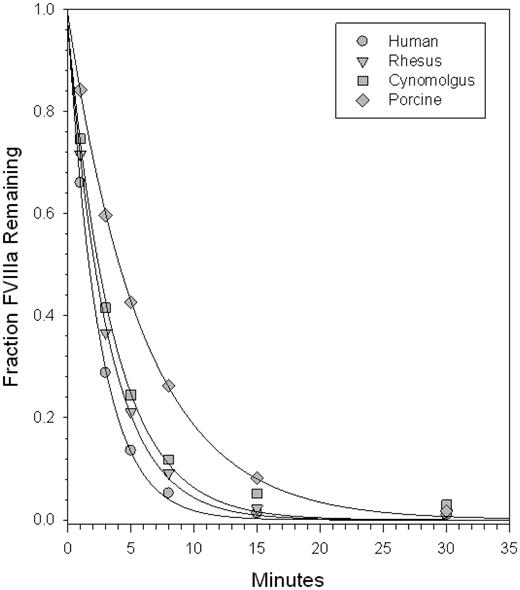Abstract
Abstract 3164
Poster Board III-104
The proteolytic conversation by thrombin of factor VIII (fVIII) to fVIIIa produces a A1/A2/A3-C1-C2 heterotrimer that spontaneously dissociates into inactive A1/A3-C1-C2 and A2 species. Human mutations that increase the rate of A2 subunit dissociation produce hemophilia A, indicating that A2 subunit dissociation is physiologically relevant and is an important regulatory feature of the blood coagulation mechanism. The A2 subunit dissociation rate from human fVIIIa is significantly faster than the corresponding dissociation rates from porcine or murine fVIIIa. The fast decay rate of human fVIIIa raises the question whether the f8 gene is under positive selection for this trait. To determine whether fast A2 dissociation occurs elsewhere in the primate lineage, we cloned cDNAs encoding B-domain deleted (BDD) fVIII from rhesus macaque and cynomolgus monkey liver. The deduced BDD amino acid sequences of rhesus and cynomolgus fVIII were 97.9 % and 98% identical to human fVIII, respectively, and were 99.9% identical to each other. The expression of rhesus and cynomolgus fVIII from baby hamster kidney-derived cells was similar to human fVIII and ten-fold lower than porcine fVIII. BDD human, rhesus, cynomolgus, and porcine fVIII molecules were purified to homogeneity by tandem ion-exchange chromatography. Concentrations of the purified constructs were calculated using a molar extinction coefficient at 280 nm based on their predicted tyrosine, tryptophan and cysteine compositions. Human, rhesus, and cynomolgus fVIII displayed similar specific coagulant activities by one-stage coagulation assay (6800, 4500, and 5200 units per mg, respectively). The kinetics of decay of human, rhesus, cynomolgus and porcine fVIIIa were measured following rapid activation of 1 nM fVIII by thrombin using a chromogenic substrate assay of purified intrinsic fXase complex under conditions in which fVIIIa was limiting. Decay curves were fit using nonlinear least-squares regression to a first-order model (Fig. 1). Decay rate constants for rhesus and cynomolgus fVIIIa were similar (0.31 and 0.27 min-1, respectively) and were slightly, but significantly lower than human fVIIIa (0.40 min-1). In contrast, the decay rate constant for porcine fVIIIa, 0.17 min-1, was 2.3-fold lower than human fVIIIa, consistent with previous observations. These results suggest that fast A2 subunit dissociation rates evolved before evolution of the primate lineage.
No relevant conflicts of interest to declare.
Author notes
Asterisk with author names denotes non-ASH members.


